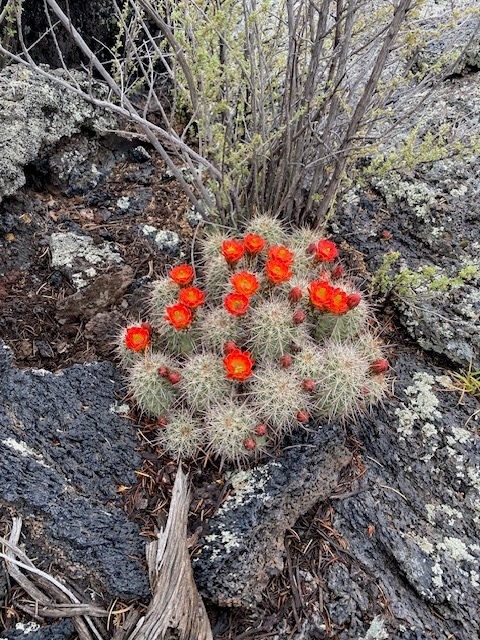
“…to give them beauty for ashes…”
– Isaiah 61:3
The brightness of a splotch of color caught my attention. I was hiking in a lava field in El Malpais National Monument. This national park is known as the Land of Frozen Fire and means badlands in Spanish. It is 114,000 acres and home to lava fields, stunning sandstone cliffs, and stretches of green prairie.
The bright red color that caught my attention was a cactus blooming with flowers. I had never seen the blooms of a cactus and was excited to witness it. As I continued my hike, I found more cacti blooming and kept stopping to take my pictures. My husband urged me to stop taking pictures and hurry along as a storm quickly approached with dark clouds and thunderbooms.
But I was simply awestruck by the beauty. The contrast between the hardened lava and the approaching storm made the wonder of the persistence of life and beauty thriving even more spectacular.
Leadership Crucibles
Reflecting on this experience, I thought of a lava bowl I had entered. This bowl is not just the base of a lava field but also a 360-degree lava wall. In the middle of this bowl was a tree with a cactus blooming under it. The bowl made me recall a term called leadership crucibles. This term was coined by Warren Bennis and Robert Thomas, who defined it as:
“A crucible is, by definition, a transformative experience through which an individual comes to a new or an altered sense of identity.”
They also go on to clarify its importance in leadership:
“Indeed, our recent research has led us to conclude that one of the most reliable indicators and predictors of true leadership is an individual’s ability to find meaning in negative events and to learn from even the most trying circumstances. Put another way, the skills required to conquer adversity and emerge stronger and more committed than ever are the same ones that make for extraordinary leaders.”
The blooming cactus gave me a word picture of what can emerge from devastation to something more. I was talking to a leader who loves engaging in art. She stated that attending art school taught her that failure is a part of the process and can be a tool to create something new. Through engaging in art, she learned not to fear failure. And this is very evident in the powerful way she leads.
How to Emerge from Your Crucibles
Bennis and Thomas go on to say:
“For the leaders we interviewed, the crucible experience was a trial and a test, a point of deep self-reflection that forced them to question who they were and what mattered to them. It required them to examine their values, question their assumptions, hone their judgment. And, invariably, they emerged from the crucible stronger and more sure of themselves and their purpose—changed in some fundamental way.”
When we encounter a crucible, we often want to get through it as quickly as possible and forget about it. This is a natural reaction to feeling threatened. However, those who thrive are the ones who tame this inclination. Nelson Mandela said, “I learned that courage was not the absence of fear, but the triumph over it. The brave man is not he who does not feel afraid, but he who conquers that fear. “
A key word in Mandela’s quote is “I learned.” It is not like people are born with this. Leadership crucibles are the process of learning. Great leaders learn through the good, the bad, and the ugly.
Here are some action steps:
Carve out space for self-reflection and use the experience to reflect on 2 sides of a coin:
- What did you realize is a non-negotiable in your life through this crucible experience?
- These can be things you will remain faithful to even if it leads to more hardship. This will often clarify core values. What is most important to you?
- What do you realize you need to change through this crucible experience?
- These are often underlying assumptions that we need to overcome. Sometimes we let other’s assumptions or judgments of us define us and hold us back. Or, we can have assumptions about ourselves, others, or the world around us that have become a barrier. It can be a change in perspective and potential.
Create Your Own Narrative
In my work with organizations, I hear more and more about people discussing the importance of storytelling. Stories can be powerful in influencing or motivating others. Some organizations want their people to effectively use stories to convey ideas within a team and outside of the organization as a form of marketing.
Yet, I think we sometimes miss out on the power of storytelling in our own lives. Your very life has a story to tell. Crucible experiences are opportunities to define your narrative. Will the crucible lead you to a narrative of being a victim or hopeless? Or, can you define a narrative that encapsulates what you have learned, clarifies who you are, and how you have transformed?
You may not have control over the lava fields and storms in your life, but you do have control over your narrative and how it tells the story of your purpose. Powerful leaders identify beauty and create a narrative within themselves to capture that beauty and share it with others.
Book Recommendations
Books can be written in various ways and be beneficial. A type of writing that I enjoy is narrative form. In this form, leaders share their stories to convey points of learning and encouragement. Think about a well-known leader that you admire. Then, search to see if there has been a biography or article written about them, and add them to your reading list.
I also recommend the book Discover Your True North by Bill George. In this book, he shares the stories of multiple leaders. This book also has a chapter that discusses Leadership Crucibles.
